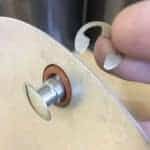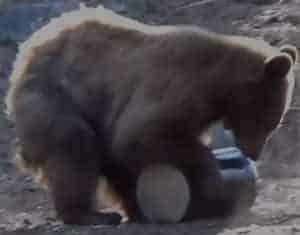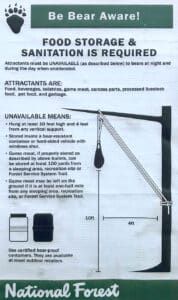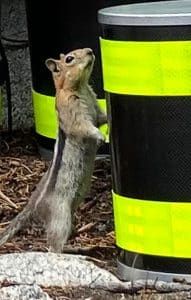
Bearikade Facts:
Bearikades are used by these and many other groups: National Park Service Rangers, Wildfire Fighters, Search & Rescue, U.S. State Department, Boy Scouts of America, Alaskan Hunting Guides
Bearikade food canisters have a very long life. We have monitored the health of the first 300 Bearikades issued to the NPS in 2000 and found them serviceable today.
Most Bearikade food canisters have been sold in North America, but they have also been shipped to: Japan, France, Belgium, Germany, United Kingdom, New Zealand and Australia.
Bearikades are proudly made in the USA.

Proprietary composite cylinder
What is the Bearikade made from?
The patented Bearikade canisters principally consist of 6061 T-6 aluminum hatch, locking collar, and end fittings securely bonded to a proprietary composite carbon-fiber cylinder with high strength epoxy.
Is the Epoxy Holding the Locking Collar and End Cap to the Cylinder Strong?
The epoxy used to bond the Bearikade together is adapted from other applications such as masts for Americas Cup sailboats and stealth Aircraft. The epoxy is very strong.
Why does it cost so much?
Every ounce counts for lightweight backpacking gear. The Bearikade is hand crafted with great care in Santa Ynez, California USA using metal parts and composite cylinders made in the USA.
Is the Bearikade water resistant?
The Bearikade utilizes O-rings between the fasteners and hatch and between the hatch and locking collar. When sealed properly (the seal must not have any debris on the O-rings), the O-rings are under compression and offer a very tight seal against water.
How hard (for humans) is it to get inside a Bearikade?
The Bearikade features 3 quarter-turn fasteners that are equally spaced around the hatch. With a quarter, key, screw-driver, etc., it only requires a modest turn to open/close the fasteners. The force is similar to opening a deadbolt with a key.
How well does my food fit inside a Bearikade?
We designed the Bearikade with you, the user, in mind. The opening has twice the area of plastic canisters with tapered ends. The locking collar fits over the cylinder with a very small amount of overhang in the useable area. This allows you to pack those large freeze-dried foods with ease. Pots, pans and stoves will fit too. No more small hatches to mess with.
Has the Bearikade been tested with bears?
The Bearikade has been subjected to the ultimate test – hungry bears! The Bearikade passed both captive Grizzly and Black Bear testing in 2000. It also passed machine based standardized structural testing in the same year. The Bearikade has been in field service all over North America since 1998. No food has ever been lost to a wild animal from a properly locked Bearikade. That is a test regimen far more rigorous and meaningful than anyone could possibly simulate in the lab or in tests with zoo animals.
How do I use the Bearikade in camp?
1. Place food in plastic bag before loading in canister
2. Toiletries and other items with odor can be stored in canister
3. Always lock all three hatch studs when stowing
4. Store away from tent, but do not attempt to secure in place (this will only give leverage to bears and other animals)
5. Place away from fast moving water and ledges
6. Smooth ground before using as a chair
7. Never use your food canister as a cookpot over a stove or campfire. Service temperature of the high strength adhesive is from -67F to 180F.
Bearikade Maintenance
Your Bearikade food canister requires very little maintenance.
The only moving parts are the quarter turn Dzus fasteners with nitrile o-rings under their heads. Please see this detailed post:
Bearikade Dzus O-Ring Maintenance
How to disassemble the Hatch in order to change seals
When you notice the torque needed to turn the fastener is higher than you want, it is probably time to clean and re-lubricate the o-rings under the fastener heads. Use Super Lube synthetic grease or equivalent.

If the torque remains too high, then you can adjust by using a pair of vise grips to squeeze the gold wire (receptacle) closer to the aluminum tab just above it. Bend a little, then try the torque and repeat as necessary. Avoid clamping rivets.
If you need assistance, call 805-693-0550.
Thanks for choosing the Bearikade.
Why use a canister?
You have planned for this trip all year and now here you are on your first night out. You have been walking all day and having finished dinner you are after some hard earned sleep in your tent.
SCRATCH, CRUNCH CRUNCH.
In the wee hours you are shaken from your slumber by a noise which sounds like something – like an animal getting into your foodbag!
Alarmed and realizing it is a LARGE animal getting your food – MAYBE A BEAR – you search your soul to find the courage to go out and try and rescue your food and the rest of your trip. Fighting the fog of sleep you run out of your tent screaming, banging on a pot and the bear runs off. Miraculously, you are unhurt
BUT …
Your food is gone!
Fortunately, you tell yourself, you were only one night out on the five day trip and not three nights out.
Slowly you realize that your trip is over.
Or You Could Have Slept.
This is an all too common occurrence these days. In fact, many backpackers actually have a carefully imagined plan in the event this happens.
There is a way to save your sleep, protect your food and in doing so insure your trip.
If your food had been in an ultra-lightweight Bearikade, your biggest decision would have been whether to get up and take a picture of the bear or roll over and go back to sleep.
The Problem
Bears can easily take the food from your pack, tent, vehicle, or the tree where you hung it, whenever they want to, according to the U.S. National Park Service. Doing so is a piece of cake, so to speak, for a grizzly or any other bear, not to mention a raccoon, fox, marmot, or even a mouse.
Everyone loses when you don’t effectively protect your food. You could lose the last several days of your trip, hurrying to the nearest supermarket on an empty stomach. And your tent or pack could be destroyed, or your vehicle badly damaged, by the hungry animal. The next dozen people whom the bear meets might lose their food, too.
Or worse.
Finally, a fed bear is a dead bear. The bear might lose his life because of what you helped to teach him. Rangers will kill bears, whether a whole family of black bears or a single black bear juvenile, for the safety of humans, if a bear’s experience with your food teaches it that “human presence equals easy food.”




